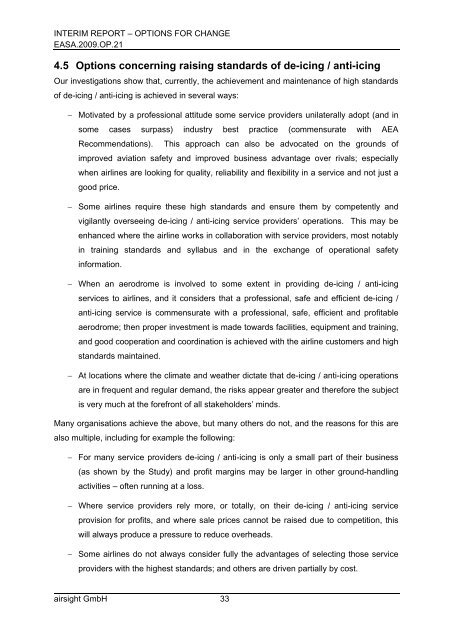Interim Report - Introduction - EASA
Interim Report - Introduction - EASA
Interim Report - Introduction - EASA
Create successful ePaper yourself
Turn your PDF publications into a flip-book with our unique Google optimized e-Paper software.
INTERIM REPORT – OPTIONS FOR CHANGE<br />
<strong>EASA</strong>.2009.OP.21<br />
4.5 Options concerning raising standards of de-icing / anti-icing<br />
Our investigations show that, currently, the achievement and maintenance of high standards<br />
of de-icing / anti-icing is achieved in several ways:<br />
− Motivated by a professional attitude some service providers unilaterally adopt (and in<br />
some cases surpass) industry best practice (commensurate with AEA<br />
Recommendations). This approach can also be advocated on the grounds of<br />
improved aviation safety and improved business advantage over rivals; especially<br />
when airlines are looking for quality, reliability and flexibility in a service and not just a<br />
good price.<br />
− Some airlines require these high standards and ensure them by competently and<br />
vigilantly overseeing de-icing / anti-icing service providers’ operations. This may be<br />
enhanced where the airline works in collaboration with service providers, most notably<br />
in training standards and syllabus and in the exchange of operational safety<br />
information.<br />
− When an aerodrome is involved to some extent in providing de-icing / anti-icing<br />
services to airlines, and it considers that a professional, safe and efficient de-icing /<br />
anti-icing service is commensurate with a professional, safe, efficient and profitable<br />
aerodrome; then proper investment is made towards facilities, equipment and training,<br />
and good cooperation and coordination is achieved with the airline customers and high<br />
standards maintained.<br />
− At locations where the climate and weather dictate that de-icing / anti-icing operations<br />
are in frequent and regular demand, the risks appear greater and therefore the subject<br />
is very much at the forefront of all stakeholders’ minds.<br />
Many organisations achieve the above, but many others do not, and the reasons for this are<br />
also multiple, including for example the following:<br />
− For many service providers de-icing / anti-icing is only a small part of their business<br />
(as shown by the Study) and profit margins may be larger in other ground-handling<br />
activities – often running at a loss.<br />
− Where service providers rely more, or totally, on their de-icing / anti-icing service<br />
provision for profits, and where sale prices cannot be raised due to competition, this<br />
will always produce a pressure to reduce overheads.<br />
− Some airlines do not always consider fully the advantages of selecting those service<br />
providers with the highest standards; and others are driven partially by cost.<br />
airsight GmbH 33

















